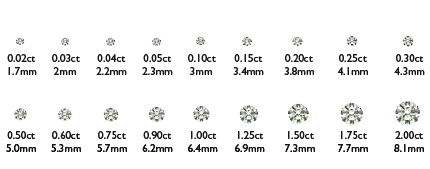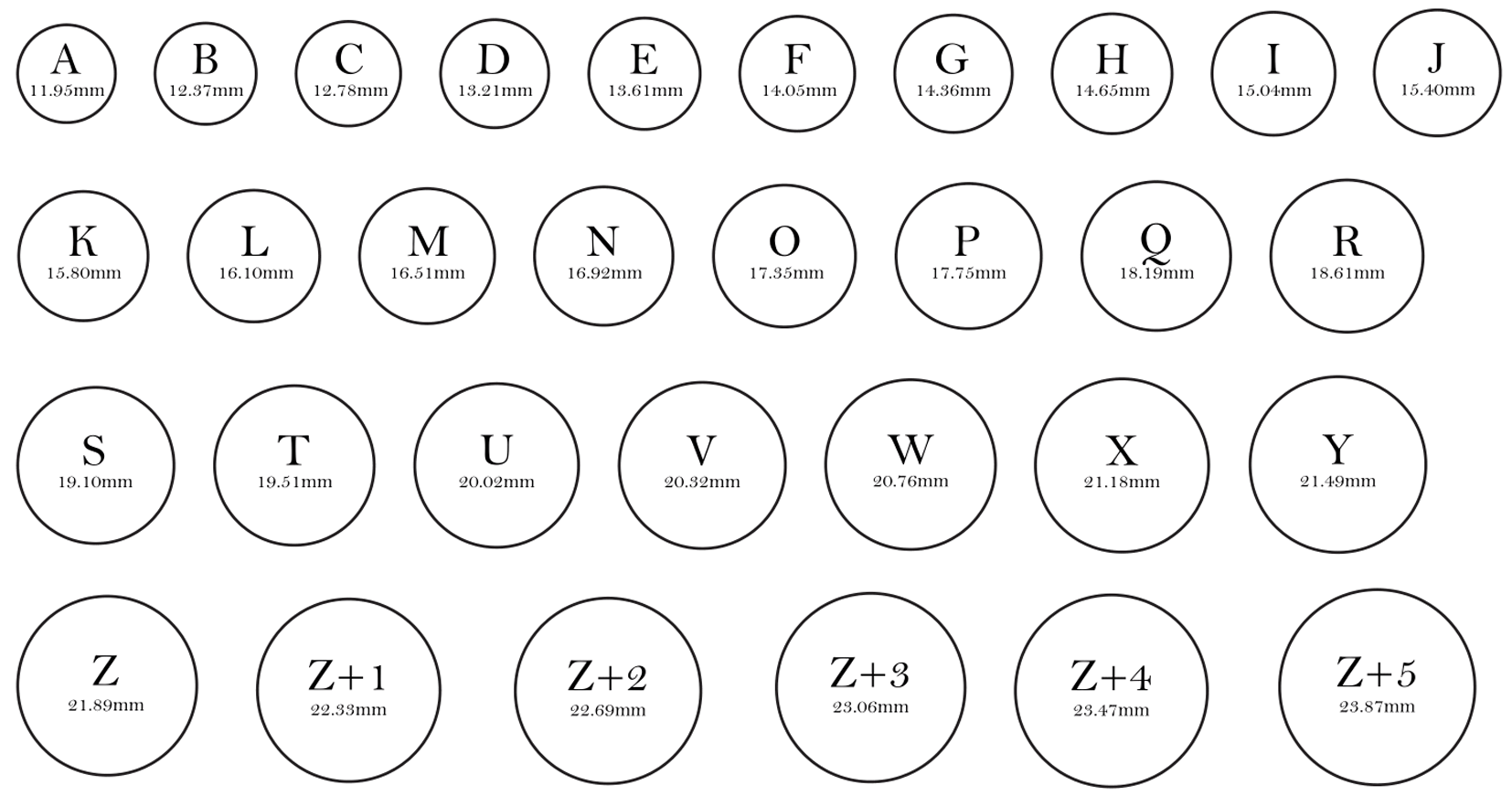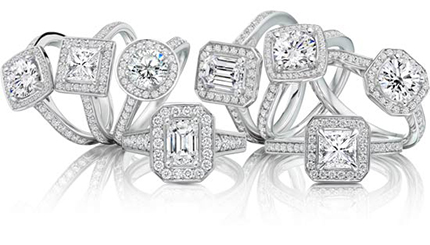A Guide to Diamonds, Metal Types and Ring Sizes
A Guide to Buying Diamonds
Raphael Collection™ diamonds are
carefully selected for their Cut, Colour and Clarity. We use a minimum standard of F/G
Colour, VS Clarity to give every ring maximum fire and brilliance.
We only source conflict free diamonds.
1. CARAT
2. CUT
3. COLOUR
4. CLARITY
1. CARAT
Diamonds are measured in terms of weight, not size. One carat is equal to 100
points.
Two diamonds of equal weight can have very different values, because the quality is
still determined by the colour, clarity and cut.

2. CUT
To transform the diamond into a beautiful gem, it is cut with precise facets. Well
cut diamonds have amazing brilliance and fire. This is caused by light reflecting
off the diamond’s surfaces.
The key to desirable fire and brilliance is proportion. Light striking a shallow cut
diamond or a diamond cut too deep is lost through the sides or bottom and is not
reflected back to the top.

3. COLOUR
While many diamonds appear colourless or white, they may actually have subtle yellow
or brown tones that can be detected when comparing diamonds side by side.
Colourless diamonds are the rarest and most valuable of all.

4. CLARITY
Clarity is an indication of a diamond’s purity.
Clarity is determined by a diamond’s naturally occurring internal characteristics
called inclusions.
These characteristics are sometimes not visible to the naked eye and they are what
make each diamond unique.
The most highly prized diamonds are those with no inclusions, otherwise known as
flawless diamonds.

ABOUT PLATINUM
Why choose Platinum over 18ct White Gold?
- Platinum is not only denser but also stronger than Gold. It is ideal for setting
diamonds in because it is very difficult to distort Platinum and this makes the
setting the perfect host for diamonds. The setting will require less maintenance
over the years.
- Platinum is a naturally occurring lustrous white metal and never discolours or
tarnishes. Gold however is naturally yellow and is mixed with elements such as
Palladium in order to give it a whiter hue. The resulting white gold alloy is often
rhodium plated to give the same bright white finish that exists in Platinum.
- Classic design and quality never goes out of fashion. Neither will Platinum.
Why is Platinum more expensive than Gold?
- The true measure of value is rarity. Platinum is one of the world's rarest precious
metals, being 35 times rarer than gold.
- A total of 10 tons of ore are required to produce just 1 ounce of platinum. In
comparison, only 3 tons of ore are required to produce 1 ounce of gold. Platinum
costs 4 or 5 times as much to refine than gold.
- Platinum is much purer than gold. All Platinum pieces
in The Raphael Collection™ are 95% pure, hence the Pt950 symbol on our hallmark, whereas 18ct Gold is 75% pure.
- Platinum is a more dense metal than gold. This means that the same item of jewellery
will weigh approximately 1.4 times heavier in Platinum than in 18ct Gold.
Is Platinum a difficult metal to work with?
If looked after properly it should not need to be repaired. Platinum requires a higher
level of craftmanship and requires great skill to work it.
What other benefits does Platinum have?
- Because of its pure properties, Platinum is fully hypoallergenic and will not
irritate the skin. Allergic reactions may occur when wearing jewellery other than
Platinum due to the alloys used in processing the metal.
- Signs of wear, including scratches, will inevitably appear in all precious metals,
even in Platinum. However due to Platinum's durability and strength, the scratch is
merely a displacement of the metal and none of its volume is lost.
- Platinum is pure, an expression of integrity, a reflection of inner truth.
- Platinum is the metal of choice, when only the best will do.
Interesting Facts About Platinum
Did you know……?
- That the name Platinum originates from the Spanish word Platina, which means “little
silver”.
- All the Platinum ever mined would fit into a typical living room.
- Annually, only 130 tons of Platinum are mined compared with 1,782 tons of Gold.
- Ten tons of ore and a five month process is needed to generate one ounce of Platinum
Bullion.
- A six inch cube of Platinum weighs 75 Kilos – about the average weight of a man.
- Platinum is often mined almost a mile underground and at temperatures exceeding 120
degrees Fahrenheit.
- Platinum’s melting point is almost double that of gold.
- One gram of Platinum can be made into a wire 2 kilometres long.
- More than 90% of all Platinum supplies come from South Africa and Russia. Virtually
all of the platinum mined in South Africa is committed to industrial contracts.
- Platinum was used by the South American Indians before the 15th Century but they
could not melt it.
- News of Platinum spread in Europe shortly after being discovered by astronomers
Antonio de Ulloa and Don Jorge Juan y Santacilia in 1735.
- Platinum started to be used in jewellery in Europe about the mid nineteenth
century.
- There is no Platinum in a Platinum record! It's plastic dipped in silver!
Common Uses of Platinum
- Used in catalytic converters for automobiles
- Making crucibles
- Coating missile nose cones
- Jet engine fuel nozzles
- Medical treatments of cancer
The Properties of the Element Platinum
- Name of Element : Platinum
- Symbol of Element : Pt
- Atomic Number of Platinum : 78
- Atomic Mass: 195.078 amu
- Melting Point: 1772.0 °C - 2045.15 °K
- Boiling Point: 3827.0 °C - 4100.15 °K
- Number of Protons/Electrons in Platinum : 78
- Number of Neutrons in Platinum : 117
- Crystal Structure: Cubic
- Density @ 293 K: 21.45 g/cm3
- Colour of Platinum : silver-white
ABOUT PALLADIUM
What is Palladium?
Palladium is a rare and lustrous silvery-white metal and belongs to the same group of
metals as Platinum.
It was first discovered by William Hyde Wallaston in 1803. Although Palladium shares
similar properties to Platinum it is much less dense - an identical piece of Palladium
jewellery will weigh 50% less than in Platinum.
Is Palladium Expensive?
The weight of Palladium is very similar to that of 14ct gold, but because Palladium is
historically less expensive than Gold per gram, Palladium jewellery is generally more
competitively priced.
Why use Palladium in Jewellery?
- Again, as Palladium is rare it is considered precious. Its properties and
characteristics make it ideal for jewellery.
- Palladium is naturally white and so it will never tarnish or change colour.
- Palladium rings never need to be rhodium plated.
- Palladium rings can be sized just like other precious metal jewellery.
- Palladium is hypoallergenic so it is ideal if your skin is sensitive.
- Palladium is harder than Platinum meaning your jewellery is extremely durable.
- Palladium is highly fashionable and its popularity is growing rapidly.
- All rings
in The Raphael Collection™ are manufactured from seamless Palladium tubing.
- There is no current legislation to hallmark Palladium Jewellery in the U.K. However
all Palladium Jewellery
in The Raphael Collection™ carries our Pd950 stamp – our guarantee to you that all our Palladium is 95% pure.
Common Uses of Palladium
- Electric contacts
- Nonmagnetic watch parts
- Surgical instruments
- Similar to gold, palladium can be beaten into a thin leaf form
- Telecommunications switching-system equipment
The Properties of the Element Palladium
- Name of Element : Palladium
- Symbol of Element : Pd
- Atomic Number of Palladium : 46
- Atomic Mass: 106.42 amu
- Melting Point: 1552.0 °C - 1825.15 °K
- Boiling Point: 2927.0 °C - 3200.15 °K
- Number of Protons/Electrons in Palladium : 46
- Number of Neutrons in Palladium : 60
- Crystal Structure: Cubic
- Density @ 293 K: 12.02 g/cm3
- Colour of Palladium : white
CHOOSING THE RIGHT SIZED RING FOR YOU
How to measure your Ring size
We pride ourselves at providing the easiest means for our valued clients to purchase
rings and other jewellery as easily as possible. To help with this, we have produced
a
downloadable guide that will provide all the necessary tools to accurately calculate
the
dimensions of your finger for selecting the right ring size for you.
Downloadable Ring size Template
Download this template and follow the steps to calculate your ring size. This
will allow you to ensure that the ring is the perfect size for you.
Printable Size Guide
Option 1: Using the Ring Sizer Tool
- Following the dotted lines, please cut out the ring sizer below.
- Cut small line, indicated by ‘Cut here’.
- Place around the finger you would like to measure, pulling the smaller end
of the ring sizer through the line cut.

Option 2: Measure with an existing ring
- Place existing ring onto the outlines below in order to determine the ring
size.
- Inside of ring should touch the edge of the circle.

Size guide reference
If you are unsure of how to use the result from your measurement guide, please see
below at the infographic showing how your value correlates to UK, US and EU ring
sizes.
| 11.95 |
A |
1/2 |
| 12.37 |
B |
1 |
| 12.78 |
C |
1 1/2 |
| 13.21 |
D |
2 |
| 13.61 |
E |
2 1/2 |
| 14.05 |
F |
3 |
| 14.36 |
G |
3 3/8 |
| 14.65 |
H |
3 3/4 |
| 15.04 |
I |
4 1/4 |
| 15.4 |
J |
4 5/8 |
| 15.8 |
K |
5 1/8 |
| 16.1 |
L |
5 1/2 |
| 16.51 |
M |
6 |
| 16.92 |
N |
6 1/2 |
| 17.35 |
O |
7 |
| 17.75 |
P |
7 1/2 |
| 18.19 |
Q |
8 |
| 18.61 |
R |
8 5/8 |
| 19.1 |
S |
9 1/8 |
| 19.51 |
T |
9 5/8 |
| 20.02 |
U |
10 1/4 |
| 20.32 |
V |
10 5/8 |
| 20.76 |
W |
11 1/4 |
| 21.18 |
X |
11 5/8 |
| 21.49 |
Y |
12 |
| 21.89 |
Z |
12 1/2 |
| 22.33 |
Z+1 |
13 |
| 22.69 |
Z+2 |
|
| 23.06 |
Z+3 |
|
| 23.47 |
Z+4 |
|
| 23.87 |
Z+5 |
|










